SE-RF-2(RL2)
Geographical Information |
|
|---|---|
| Geographical Coordinate System | Longitude :166° 19' 8.360 |
| Latitude :10° 19' 50.560 | |
| Height Above Sea Level:2.4 meters (Sheppard & Green1991: 89) | |
| Map Datum:WGS84 | |
| Country | Solomon Islands |
| Region | Western Lapita Province, Temotu, Reef Islands Group, Te Motu Taibä2 |
| Brief Description | SE-RF-2 is located on the coralline islet of Te Motu Taibä, within the Reef Islands Group, Temotu Province, Solomon Islands (Green 1976a: 247; Green 1979:51). The site runs parallel with the present coastline, 160 meters inland and is approximately 55 meters long and 26 meters wide (Sheppard & Green 1991: 89). Vegetation cover varied across the site. The southern portion of the site, consisting of a pathway and former garden was largely clear of vegetation, whereas the northern portion was covered in thick undergrowth and larger trees, including some of economic value (Green 1976: 251). SE-RF-2 is argued to represent a small settlement or “hamlet” built around one primary central structure, which may have been orientated along the prehistoric coastline (Sheppard & Green 1991: 100). SE-RF-2 was excavated in two field seasons 19723 and 1976-77 under the direction of R.C. Green (Sheppard & Green 1991: 89). |
| Photograph(s) | 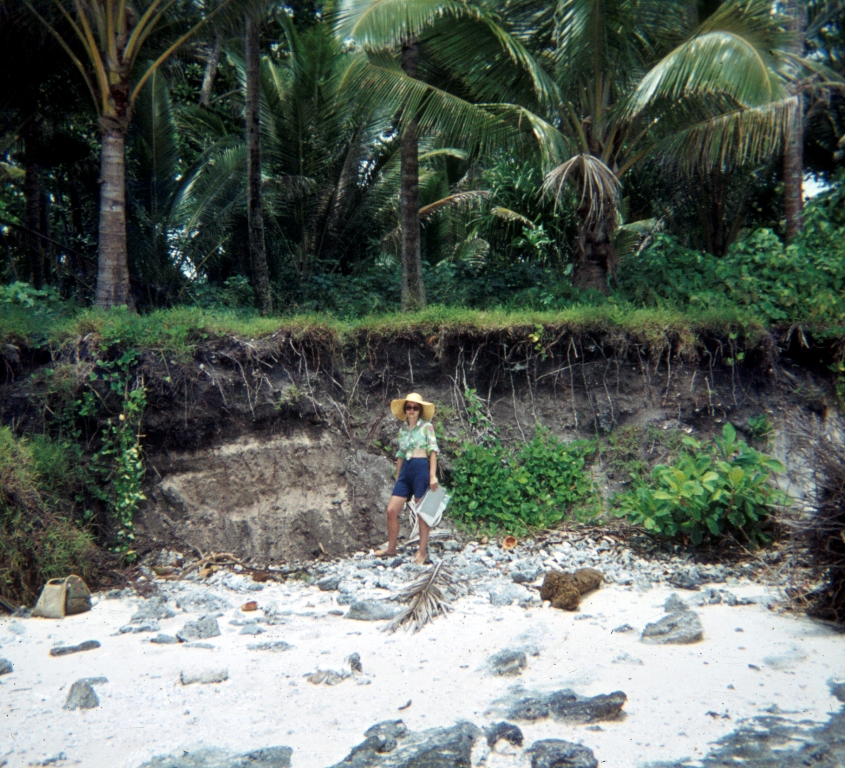  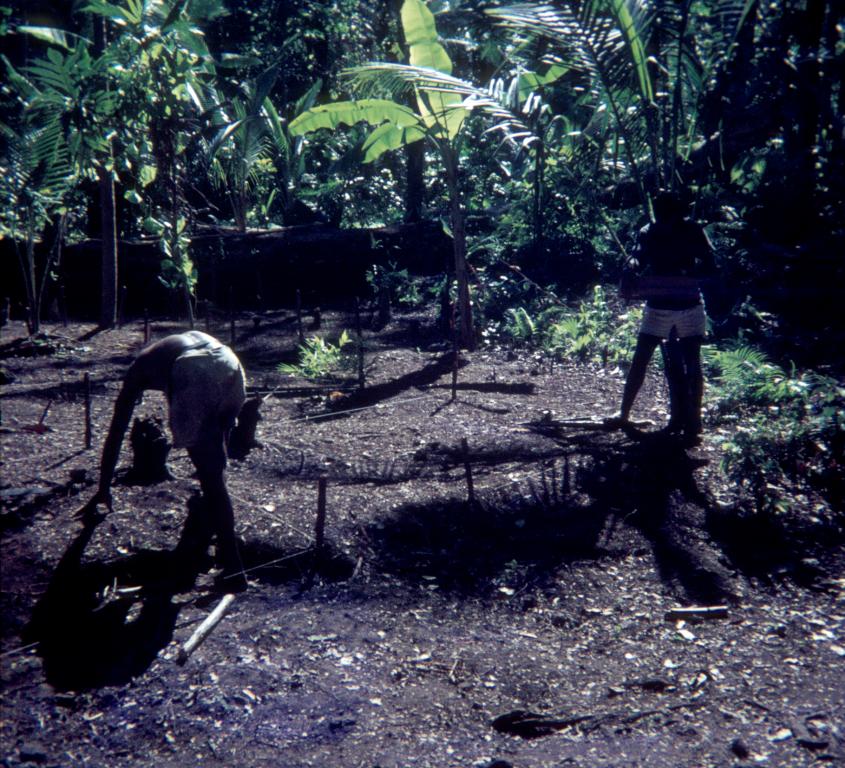 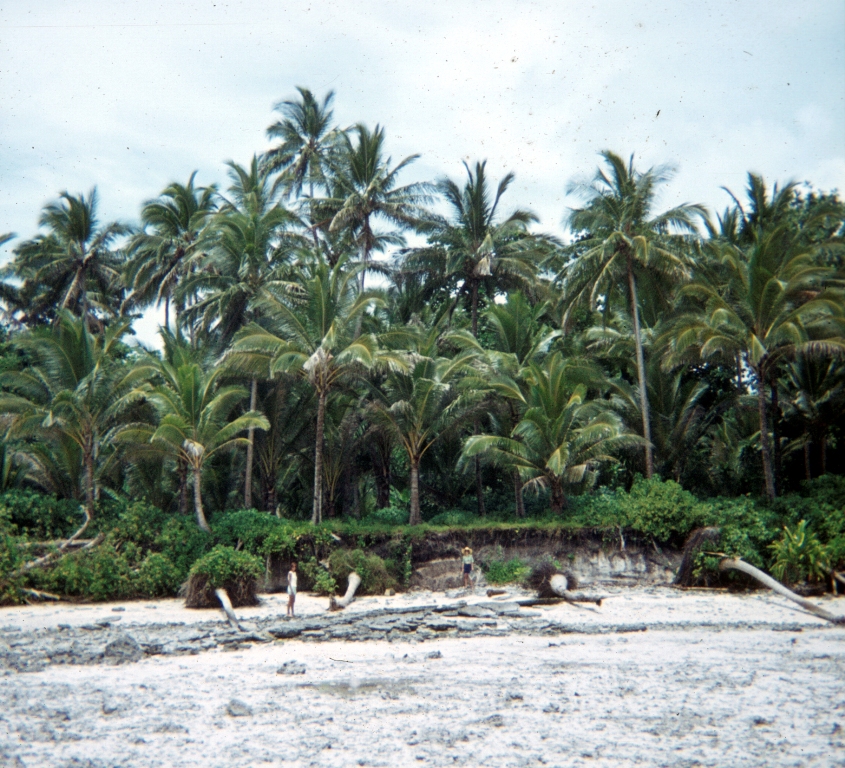 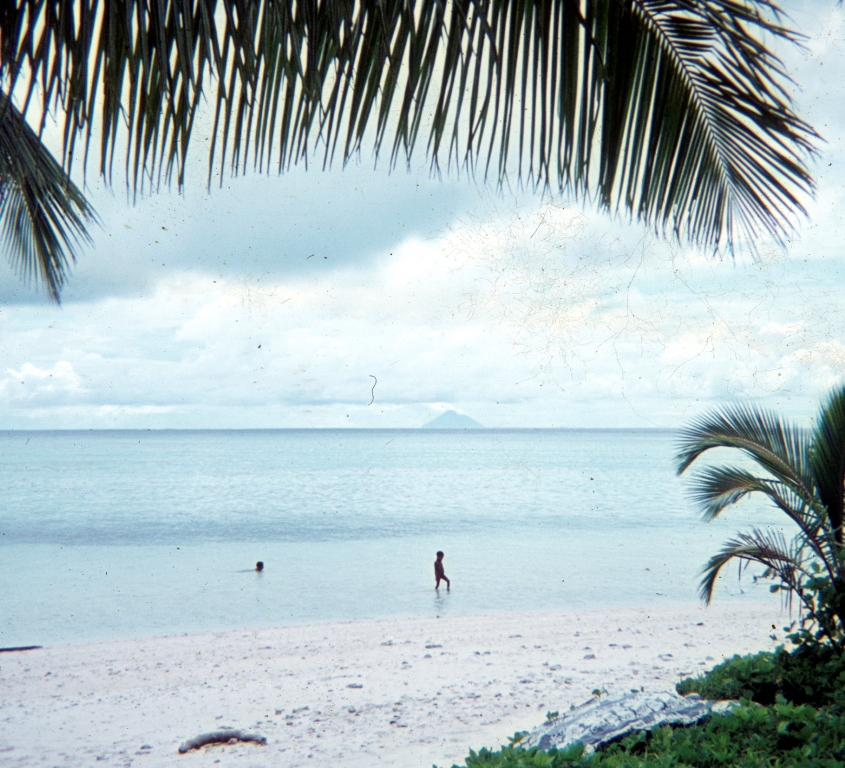 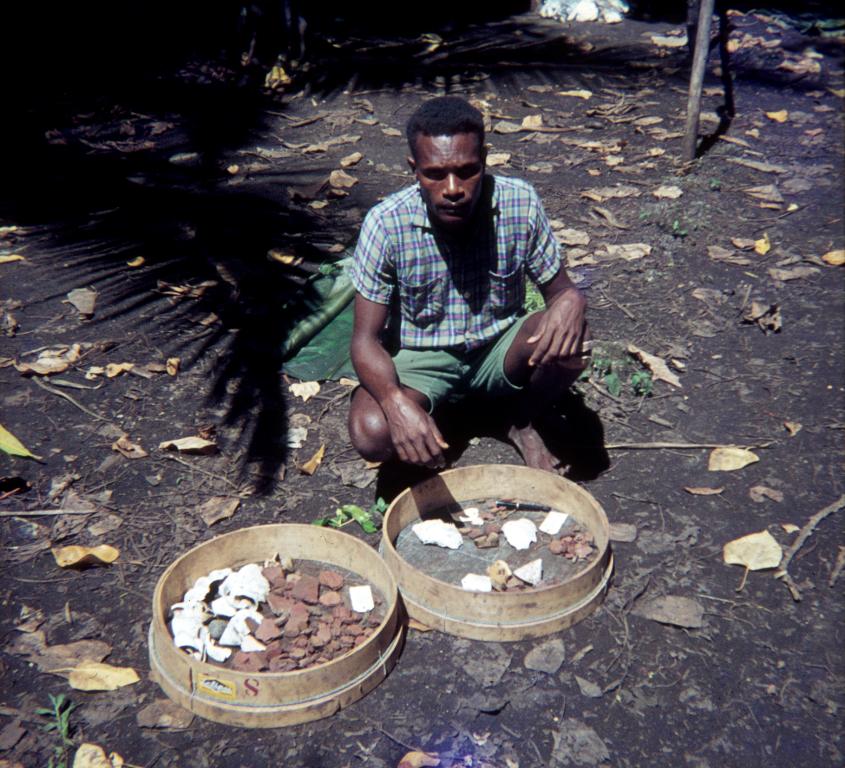 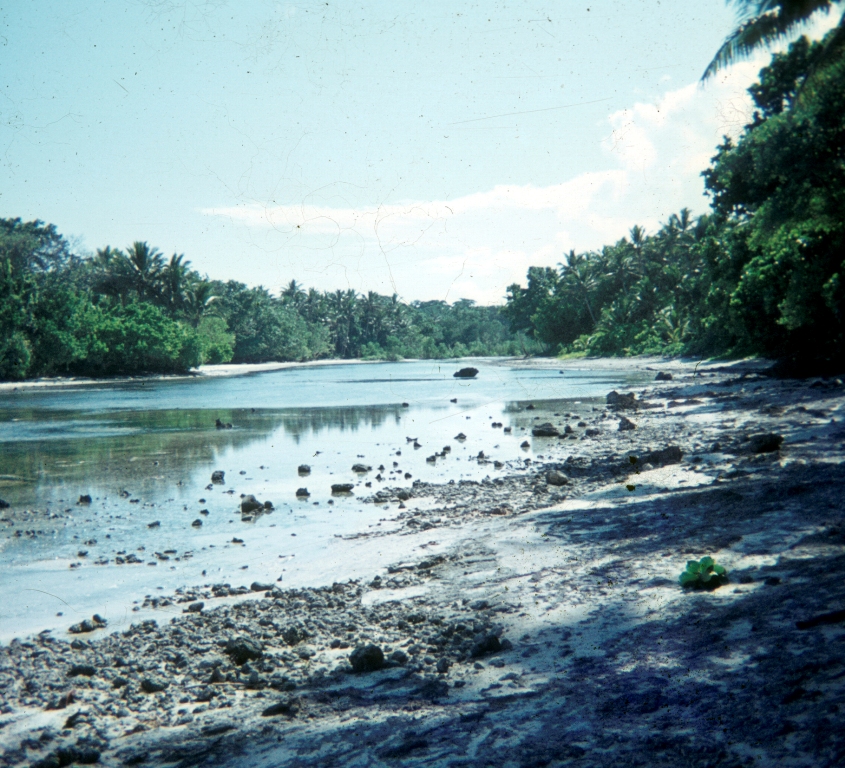 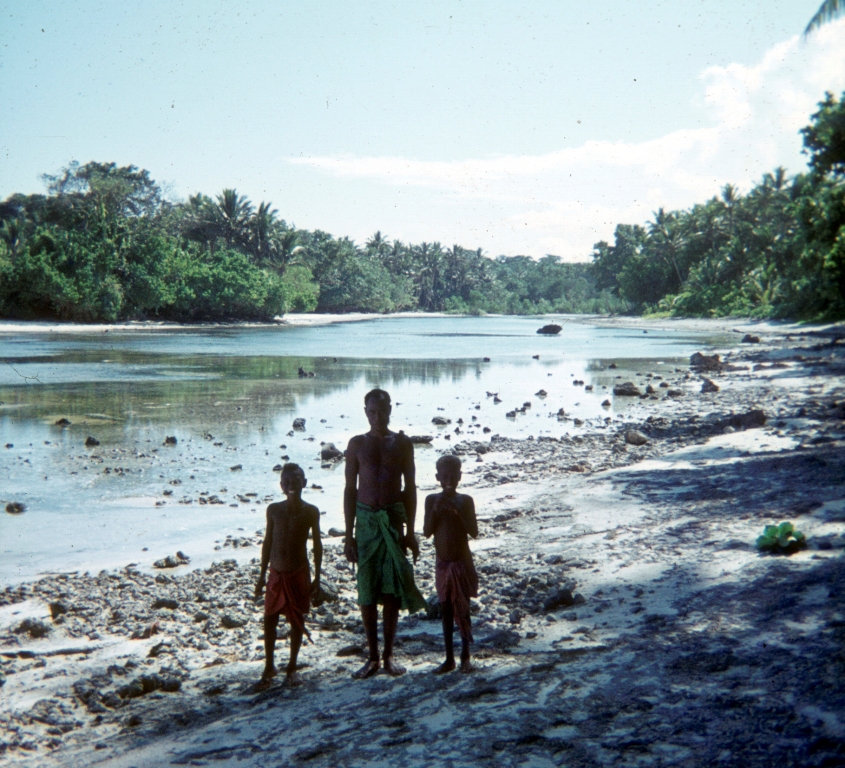 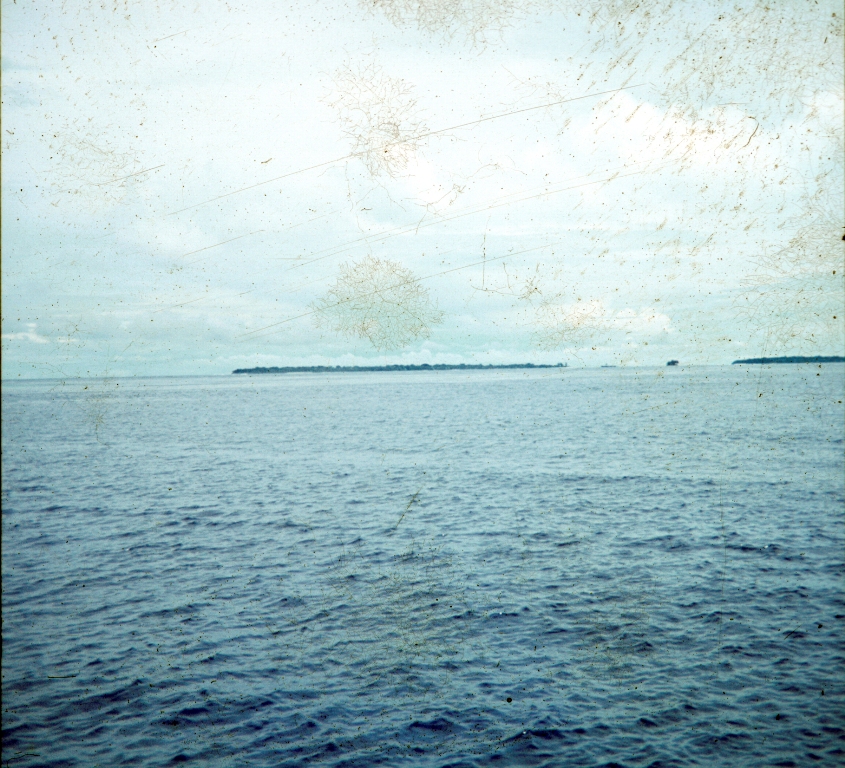 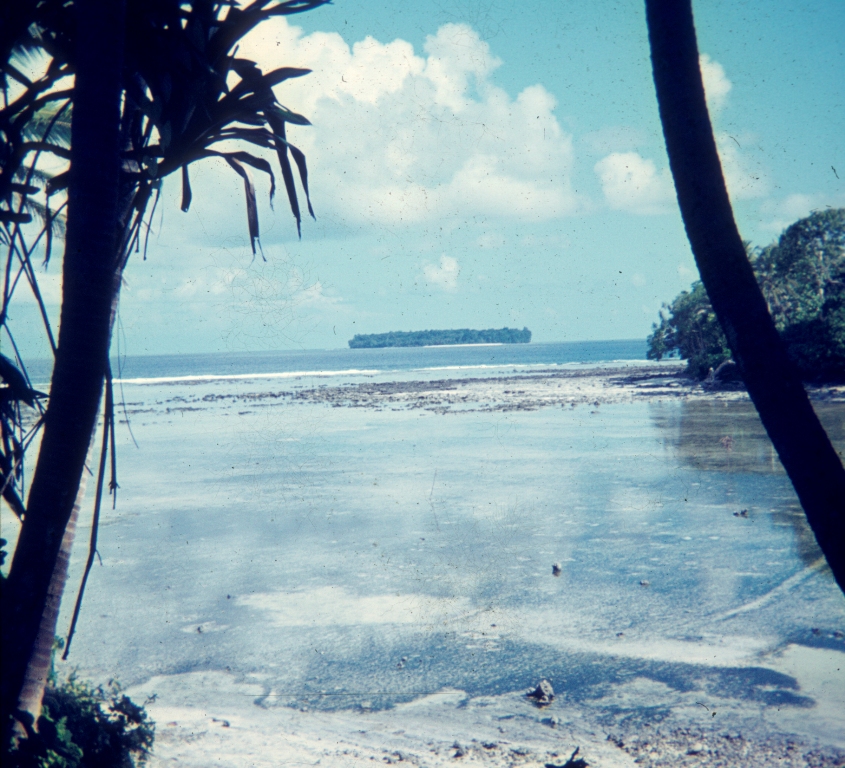 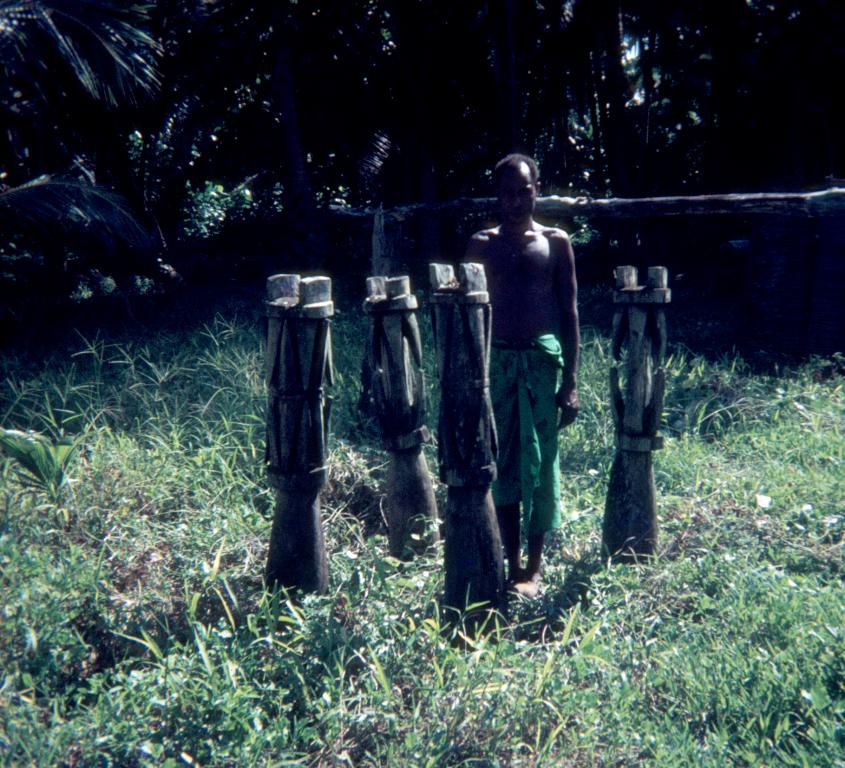 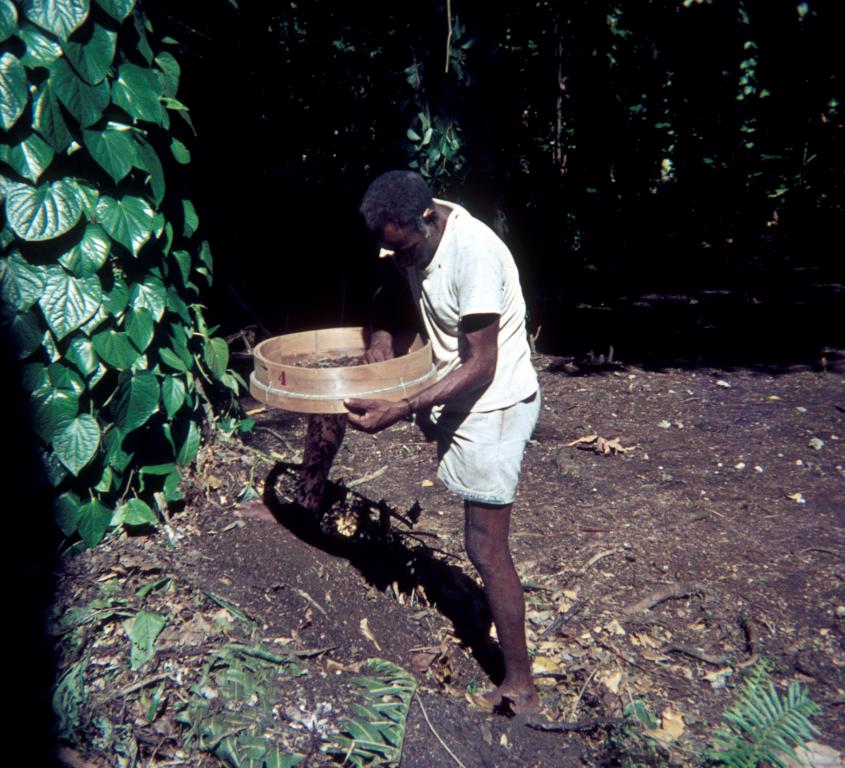 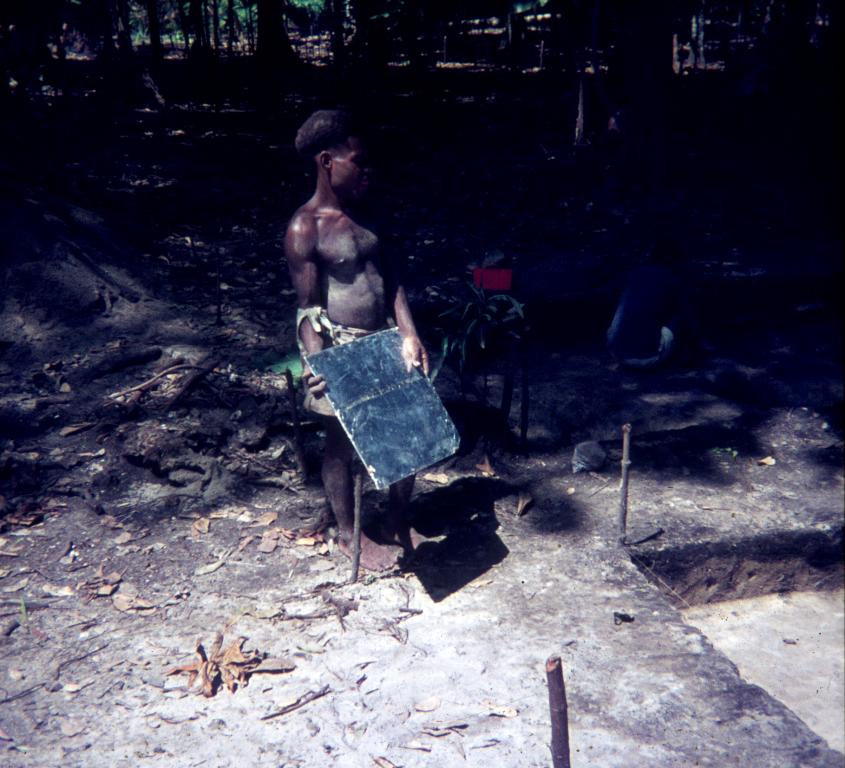 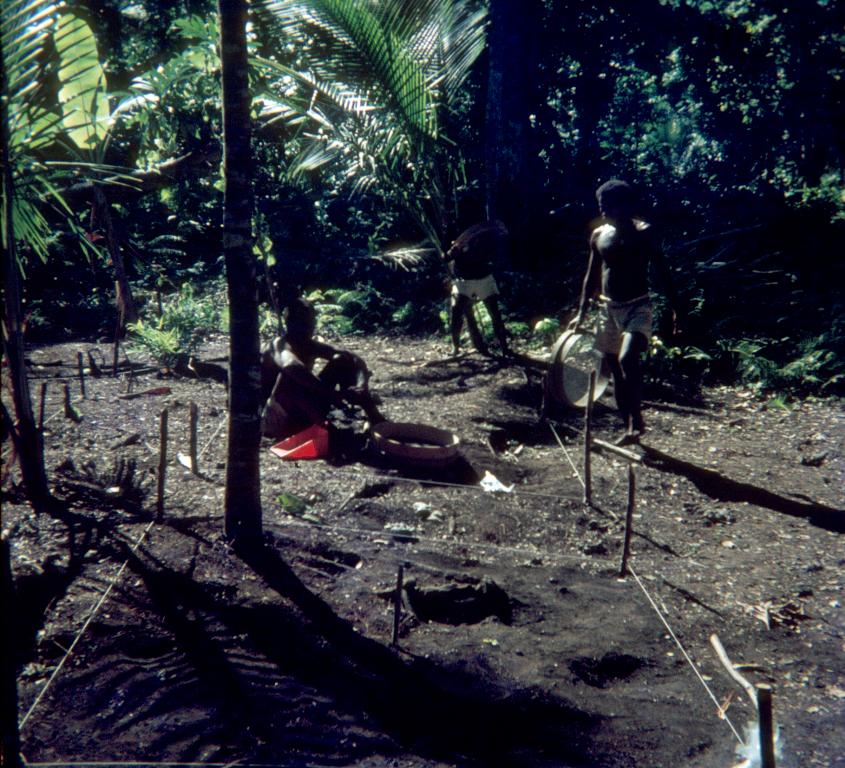 |
| Floor Plan | |
| Stratigraphy | |
Site Information |
|
| Distribution of Remain(s) | The completion of a thorough surface collection program indicated that cultural materials (especially pottery) were present, in varying densities, over the entire surface of SE-RF-2 (Sheppard & Green 1991: 89,91). An analysis by Sheppard & Green (1991), which studied the distribution of cultural remains across the site via the analysis of artifact density and frequency / weight (per square meter), found that certain forms of material culture were differentially distributed across the site. Density maps created from the surface survey indicated that an area of very high sherd density, roughly rectangular in shape (measuring 7 x 10 meters), was present in the middle of the site and that areas of predominately low sherd density were present in the northern portion of the site and moderate to high sherd density present in the southern portion of the site (Sheppard & Green 1991: 91). The excavation of 153.5 m2 (Green 2009:9) extending from the central portion of the site to the south provided further data in the form of post-holes, pit features and artifacts from secure contexts (Sheppard & Green 1991: 91). The analysis of the frequency and weight of the excavated lithics (chert and obsidian) and pottery illustrated that their distribution within the site was very similar to the surface material; the primary artifact concentration was in the north of the excavated area (the center of the site), a second smaller concentration was located in the south of this area (Sheppard & Green 1991: 96). However, the distribution of shell and fishbone differed markedly to lithic and pottery distributions as it was primarily (with the exception of a small amount of fishbone associated with pit features located in the center of the site) concentrated in the southern portion of the site (Sheppard & Green 1991: 95). Structural remains (in the form of post-holes and pit features) were discovered across the entirety of the excavated area (Sheppard & Green 1991: 92). Those post-holes located in the northern portion of the excavation are argued to represent a “large rectilinear structure” approximately 7m x 10m in size, whereas those in the south may represent a number of small impermanent structures and/or a wall (Sheppard & Green 1991: 93-94,100). The pit features located in the center of the site are associated with the rectilinear structure, and in at least one instance (a small row of pits), have been associated with fishbone (Sheppard & Green 1991: 95). The southern pit-features are quite varied, it is argued that at east two of the larger pits are for storage, one is a well and multiple smaller pits are likely to be earth ovens (Sheppard & Green 1991: 95). |
| Approximate Size | 800-1100 m2 (Sheppard & Green 1991: 89) |
| Preservation Condition | |
| Culture Type(s) | Lapita |
| C14Date(s) | Conventional (uncalibrated) radiocarbon dates and sample provenance information: 2955±95 BP (I-5747), Grid square W-V-26, Sample collected from a ash lens within a pit or post-hole feature - Charcoal (Jones et al. 2007: 95-96; Sheppard & Green 1991: 92, Figure 3). 2775±100 BP (I-5748), Grid square W 35-36, Sample collected from an oven located on the uppermost surface of the occupation layer - Charcoal (Jones et al. 2007: 95-96; Sheppard & Green 1991: 92, Figure 3). 2730±120 BP (ANU-6476), Grid square T-40, Sample collected from a small pit feature in the main occupation layer - Charcoal (Jones et al. 2007: 95-96; Sheppard & Green 1991: 92, Figure 3). 2850±130 BP (ANU-6477), Grid square U-40, Sample collected from a large post-hole or pit feature in the main occupation layer which partially cuts into a pit feature in grid square T-40 - Charcoal (Jones et al. 2007: 95-96; Sheppard & Green 1991: 92, Figure 3). 3100±40 BP (WK-7847), Grid square X-30/X-29, Sample collected from a pit feature in the main occupation layer - Tridacna maxima (Jones et al. 2007: 95-96; Sheppard & Green 1991: 92, Figure 3). 3080±40 BP (WK-7848), Grid square X-28/Y-28-29, Sample collected from a large pit feature in the main occupation layer - Trochus niloticus (Jones et al. 2007: 95). Summary of calibrated radiocarbon dates: Green et al. (2008: 50) estimate that, in combination with the the dates above and the marine ΔR value (only applicable for WK-7847 & WK-7848) for the Reef/Santa Cruz region determined by Jones et al. (2007: 101) (–81 ± 64 14 C yr) the site of SE-RF-2 was occupied for a period of 50 years or less and that the site dates to 2825-2983 and 2949-3145 cal BP at one standard deviation (68.2% probability) and 2724-3062 and 2878-3271 cal BP at two standard deviations (95.4% probability). |
| Artifact Type(s) | Pottery, faunal remains, lithics (flakes, points, gravers, cores, oven stones, adzes), worked shell artifacts (rectangular units, rings, beads, pendants), human bone fragments and teeth, worked bone (perforated teeth, worked tusk) (Green 1976a: 255-263; Sheppard & Green 1991:95,96-98; Sheppard 1992:149-152; Szabó 2010: 124). |
| Ceramic Type(s) | |
Cultural information |
|
| Significance | Firstly, SE-RF-2 belongs to a group of three Lapita sites (the other two being Nanggu - SE-SZ-8 and Ngamanie - SE-RF-6) located in the Reefs/Santa Cruz Islands, which represent the earliest occupation within Remote Oceania (Green et al. 2008: 49; Chiu 2012: 8). Based upon radiocarbon determinations, the site of Nanggu is argued to be the oldest of the three sites, followed by Nenumbo (see discussion of radiocarbon dates above) and lastly Ngamanie (Green 2009: 45-46; Green et al. 2008: 59; Chiu 2012: 8). Therefore SE-RF-2 is part of a complex of sites that has the ability to provide information on the beginning of Lapita settlement within Remote Oceania. Secondly, the large scale aerial excavation methods used by R.C. Green provided a rare opportunity to study settlement patterns and subsistence practices within a Lapita settlement (Sheppard & Green 1991). The data collected from the spatial analysis of the site allowed Sheppard & Green (1991: 1001-101) to make a detailed picture of how space within the settlement was being used during prehistory. It is argued that the site may represent a small hamlet, represented by a single large central structure, which at one time or another had a series of small impermanent structures located on its northern and southern ends (Sheppard & Green 1991: 100). Faunal remains excavated from the southern end of the structure, in addition to probable storage pits and earth ovens, strongly suggest that the southern portion of the site was a cooking area (Sheppard & Green 1991: 95, 100). The concentration of lithic materials in the central structure suggests that this area was the centre of technological activities in the site (Sheppard & Green 1991: 96). |
| Brief Research History | 1970 – R.C. Green conducted a reconnaissance program as part of “The Southeast Solomon Islands Cultural History Programme” (lead by R.C. Green and D.E. Yen) in the southeast Solomon Islands, allowing for the identification of SE-RF-2 along with other sites in the region (Green 1976a:246; Green 1976b: 9). 19723 – First of two field seasons lead by R.C. Green, a total of 72 m2 was excavated (Green 2009: 8). 1976-77 – Second field season lead by R.C. Green, a total of 81.5 m2 was excavated (Green 2009: 9). The two field seasons excavated a total of 153.5 m2 (Green 2009: 9). |
| Note | 1 - Formerly BS-RL-2 2 - The name of Island used here is that which has been used most recently in the literature associated with the site (Sheppard & Green 1991: 89; Jones et al. 2007:96; Green & Jones 2008: 8). However, it has had a verity of other names in earlier publications, including Ngangaua (Green 1976a: 248; Kirch 1997: 175), Ngagaue (Davenport 1969:154) and Ngawa (Hughes l98l: 22). 3 - Two possible dates have been published for the year during which first field season occurred, 1971 (Green 1972:197,199; Green 2009:8) and 1972 (Sheppard & Green 1991:89; Sheppard 1992:146). |
| Reference(s) | Best, S. 2002. Lapita: A view from the East. New Zealand Archaeological Association Monograph 24. Auckland; New Zealand: New Zealand Archaeological Association. Burnett, W.C. and C.D. Fein. 1977. Geological Report on Soil Samples from Laptia Site SE-RF-2, Solomon Islands Cultural History Project. Oceanic Prehistory Records 4: 1-22. Chiu, S. 2005. Meanings of a Lapita face: materialized social memory in ancient house societies. Taiwan Journal of Anthropology 3(1): 1-47. Chiu, S. 2007. Detailed Analysis of Lapita Face Motifs: Case Studies from Reef/Santa Cruz Lapita Sites and New Caledonia Lapita Site 13A. In S. Bedford, C. Sand and P. Connaughton (eds.), Oceanic Explorations: Lapita and Western PacificSettlement, pp. 241-264. Terra Australis 26. ANU E Press, Australian National University. Chiu, S. 2010. Lapita Pottery of the Reef/Santa Cruz Islands, Southeast Solomon Islands. In C. Sand and S. Bedford (eds.), Lapita: Ancêtres Océaniens, pp.118-119. Paris; France: Quai Branly Museum. Clough, R. 1992. Firing Temperatures and the Analysis of Oceanic Ceramics: A Study of Lapita Ceramics from Reef/Santa Cruz, Solomon Islands. In J.C. Galipaud (ed.), Poterie Lapita et Peuplement: Actes du Colloque Lapita, Nouméa, Nouvelle-Calédonie, Janvier 1992, pp. 177–192. Nouméa: ORSTOM. Davenport, W. 1969. Social organisation notes on the northern Santa Cruz Islands: The main Reef Islands. Baessler-Archiv, Neue Folge, Band VXIL, pp.l5l-243. Berlin; Germany: Baessler Archiv. Dickinson, W.R. 1978. Sand Tempers in Southeast Solomons Sherds from Feru Rockshelter on Santa Ana and Lapita Sites in the Santa Cruz Group. University of Auckland Oceanic Prehistory Records No. 7, Auckland; New Zealand: The University of Auckland. Doherty, M.W. 2007. Post-Lapita Developments in the Reef-Santa Cruz Islands, Southeast Solomon Islands. Unpublished PhD Thesis. Auckland; New Zealand: The University of Auckland. Donovan, L.J. 1973. A Study of the Decorative System of the Lapita Potters in Reefs and Santa Cruz Islands. Unpublished MA Thesis. Auckland; New Zealand: University of Auckland. Falk, B.A. 2011. Geochemical Characterisation of Lapita Ceramics from the Reef-Santa Cruz Islands: An Analysis of the SE-SZ8, SE-RF2, and SE-RF6 Ceramic Assemblages. Unpublished MA Thesis. Auckland; New Zealand: The University of Auckland. Green, R.C. 1972. Southeast Solomons Fieldwork. Asian Perspectives 15(2): 197-199. Green, R.C. 1974. Sites with Lapita Pottery: Importing and Voyaging. Mankind 9(4): 253-259. Green, R.C. 1976a. Lapita Sites in the Santa Cruz Group. In R.C. Green and M.M. Cresswell (eds.), Southeast Solomon Islands Cultural History: A preliminary Survey, pp. 245-265. The Royal Society of New Zealand Bulletin 11. Welington; New Zealand: Bryce Francis LTD. Green, R.C. 1976b. An Introduction to the Southeast Solomons Culture History Programme. Working Papers in Anthropology, Archaeology and Maori Studies No. 51. Auckland; New Zealand: Department of Anthropology, University of Auckland. Green, R.C. 1978. New sites with Lapita pottery and their implications for an understanding of the settlement ofthe Western Pacific. Working Papers in Anthropology, Archaeology and Maori Studies No. 51. Auckland; New Zealand: Department of Anthropology, University of Auckland. Green, R.C. 1979. Lapita. In J. Jennings (ed.), The Prehistory of Polynesia,pp.27-60. Cambridge; U.K: Harvard University Press. Green, R.C. 1985. An Interpretation of Source Allocations for Obsidian from Three Lapita Sites in the Reef/Santa Cruz Island Group, Southeast Solomons. Unpublished Manuscript. Green, R.C. 1986. Lapita Fishing: The Evidence of Site SE-RF-2 from the Main Reef Islands, Santa Cruz Group, Solomons. In A. Anderson (ed.), Traditional Fishing in the Pacific, pp 19-35. Honolulu,U.S.A: Bernice P. Bishop Museum. Green, R.C. 1987. Obsidian Results from the Lapita Sites of the Reef/Santa Cruz Islands. In W.R. Ambrose and J.M.J. Mummery (eds.), Archaeometry: Further Australasian Studies, pp. 239-249. Canberra; Australia: Australian National University. Green, R.C. 1991a. The Lapita Cultual Complex: Current evidence and proposed models. Bulletin of the Indo-Pacific Prehistory Association 11: 295–305. Green, R.C. 1991b. A reappraisal of the dating for some Lapita sites in the Reef/Santa Cruz Group of the Southeast Solomons. Journal of the Polynesian Society 100(2): 197-207. Green, R.C. 1996. Prehistoric Transfers of Portable Items during the Lapita Horizon in Remote Oceania: A Review. In I.C. Glover and B. Bellwood (eds.), Indo-Pacific Prehistory: The Chiang Mai Papers, Vol. 2, pp. 119-130. Canberra; Australia: Australian National University. Green, R.C. 2009. An evaluation of sample adequacy for the Lapita-style ceramic assemblages from three sites located in the Reef/Santa Cruz Group, Outer Eastern Islands of the Solomons. Research in Anthropology & Linguistics-e No. 4, pp.1-64. Auckland; New Zealand: Department of Anthropology, The University of Auckland. Green, R.C. 2010. The Outer Eastern Islands of the Solomons: a Puzzle for the Holistic Approach to the Anthropology of History. In J. Bowden, N. P. Himmelmann and M. Ross (eds.), A Journey through Austronesian and Papuan Linguistic and Cultural Space: Papers in Honour of Andrew Pawley, pp. 207-223. Canberra; Australia: Pacific Linguistics. Green, R.C. and J.R. Bird.1989. Fergusson Island Obsidian from the D'Entrecasteaux Group in a Lapita Site of the Reef/Santa Cruz Group. New Zealand Journal of Archaeology 11: 87-99. Green, R.C. and M. Jones. 2008. The Absolute Age of SE-RF-6 (Ngamanie) and its Relation to SE-RF-2 (Nenumbo): Two Decorated Lapita Sites in the Southeast Solomon Islands. New Zealand Journal of Archaeology 29: 5-18. Green, R.C., Jones, M. and P. Sheppard. 2008. The Reconstructed Environment and Absolute Dating of SE-SZ-8 Lapita Site on Nendö, Santa Cruz, Solomon Islands. Archaeology in Oceania 43 (2): 49-61. Green, R.C. and D.E. Yen. 2009. The Southeast Solomon Islands culture history project: Principal investigators’ overview of the 1970s project including recent and current research. In P.J. Sheppard, T. Thomas and Glenn R. Summerhayes (eds.), Lapita: Ancestors and descendants, pp. 147-172. New Zealand Archaeological Association Monograph 28. Auckland; New Zealand: New Zealand Archaeological Association. Hughes, G. 198l. The Reef Islands. In G. Hughes, P. Craig and R. Dennis (eds.), Geology of the Eastern Outer Islands,pp.l7-24. Honiara; Solomon Islands: Solomon Islands Government, Ministry of Natural Resources, Geological Survey Division. Jones. M., Petchey, F., Green, R.C., Sheppard, P. and M. Phelan. 2007. The Marine ΔR for Nenumbo (Solomon Islands): A case study in calculating reservoir offsets from paired sample data. Radiocarbon 49(1): 95-102. Parker, V.N.M. 1981. Vessel forms of the Reef Island SE-RF-2 Site and their Relationships to Vessel forms in Other Western Lapita Sites of the Reef/Santa Cruz and Island Melanesian Area. Unpublished MA Thesis. Auckland; New Zealand: University of Auckland. Sheppard, P.J. 1992. A report on the flaked lithic assemblages from three Southeast Solomons Lapita Sites (SE-SZ-8, SE-RF-2, SE-RF-6). In J.C. Galipaud (ed.), Poterie Lapita et Peuplement: Actes du Colloque Lapita, Nouméa, Nouvelle-Calédonie, Janvier 1992, pp. 145–153. Nouméa: ORSTOM. Sheppard, P.J. 1993. Lapita Lithics: Trade/Exchange and Technology. A View from the Reefs/Santa Cruz. Archaeology in Oceania 28 (3): 121-137. Sheppard, P.J. and R.C. Green. 1991. Spatial analysis of the Nenumbo (SE-RF-2) Lapita site, Solomon Islands. Archaeology in Oceania 26: 89-101. Sheppard, P.J. and L.A. Pavlish. 1992. Weathering of Archaeological Cherts: A case study from the Solomon Islands. Geoarchaeology: An International Journal 7(1): 41-53. Sheppard, P. J. and R. Walter. 2006. A revised model of Solomon Islands culture history. Journal of the Polynesian Society 115(1): 47-76. Sheppard, P.J. and R.C. Green. 2007. Sample Size and the Reef/Santa Cruz Lapita Sequence. In S. Bedford, C. Sand and P. Connaughton (eds.), Oceanic Explorations: Lapita and Western Pacific Settlement, pp. 289–299. Terra Australis 26. ANU E Press, Australian National University. Sheppard, P., Trichereau, B. and C. Milicich. 2010. Pacific obsidian sourcing by portable XRF. Archaeology in Oceania 45: 21-30. Swadling, P. 1986. Lapita Shellfishing: Evidence from Sites in the Reef Santa Cruz Group, Southeast Solomon Islands. In A. Andersan (ed.), Traditional Fishing in the Pacific, pp. 137-148. Honolulu; U.S.A: Department of Anthropology, B. P. Bishop Museum. Szabó, K. 2005. Technique and Practice: Shell-Working in the Western Pacific and Island Southeast Asia. Unpublished PhD Thesis. Canberra; Australia: Department of Archaeology and Natural History, Australian National University. Szabó, K. 2010. Shell Artefacts and Shell-Working within the Lapita Cultural Complex. Journal of Pacific Archaeology 1(2): 115-127. Yen, D.E. 1982. The Southeast Solomon Islands Cultural History Programme. Bulletin of the Indo-Pacific Prehistory Association 3: 52-66. |

